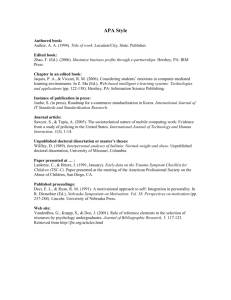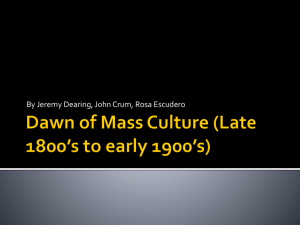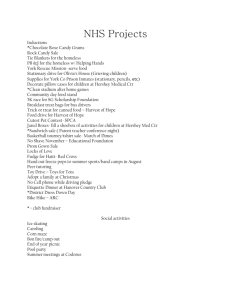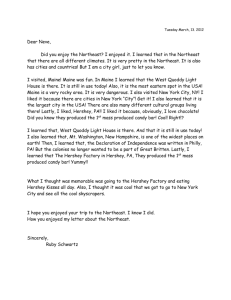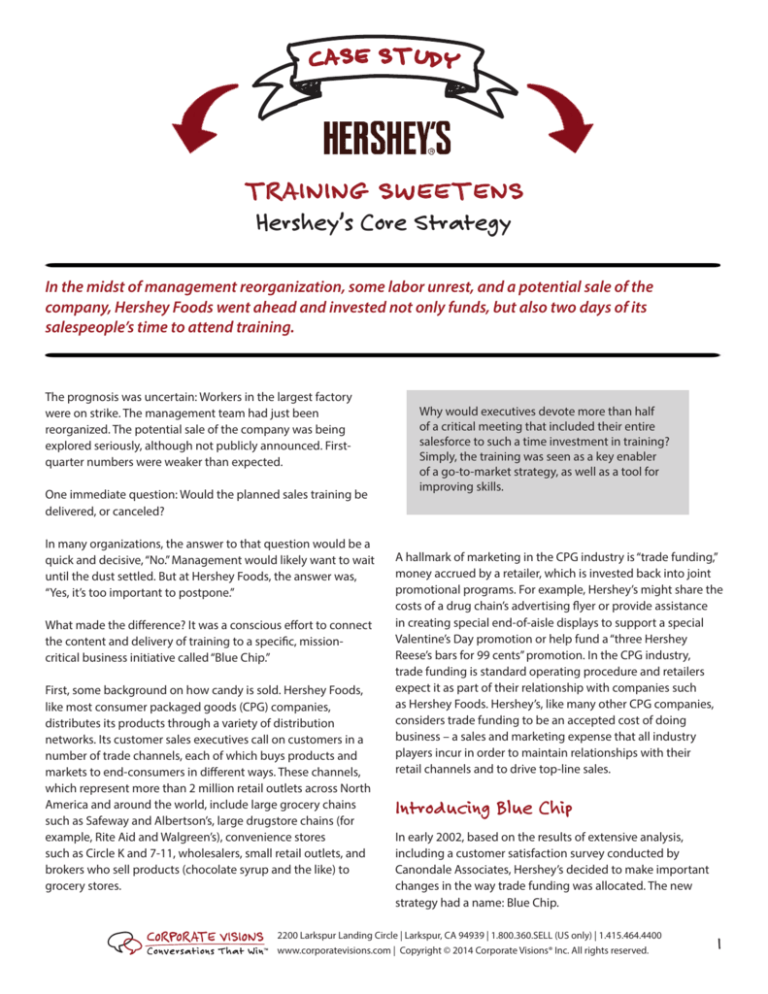
CASE STUDY
TRAINING SWEETENS
Hershey’s Core Strategy
In the midst of management reorganization, some labor unrest, and a potential sale of the
company, Hershey Foods went ahead and invested not only funds, but also two days of its
salespeople’s time to attend training.
The prognosis was uncertain: Workers in the largest factory
were on strike. The management team had just been
reorganized. The potential sale of the company was being
explored seriously, although not publicly announced. Firstquarter numbers were weaker than expected.
One immediate question: Would the planned sales training be
delivered, or canceled?
In many organizations, the answer to that question would be a
quick and decisive, “No.” Management would likely want to wait
until the dust settled. But at Hershey Foods, the answer was,
“Yes, it’s too important to postpone.”
What made the difference? It was a conscious effort to connect
the content and delivery of training to a specific, missioncritical business initiative called “Blue Chip.”
First, some background on how candy is sold. Hershey Foods,
like most consumer packaged goods (CPG) companies,
distributes its products through a variety of distribution
networks. Its customer sales executives call on customers in a
number of trade channels, each of which buys products and
markets to end-consumers in different ways. These channels,
which represent more than 2 million retail outlets across North
America and around the world, include large grocery chains
such as Safeway and Albertson’s, large drugstore chains (for
example, Rite Aid and Walgreen’s), convenience stores
such as Circle K and 7-11, wholesalers, small retail outlets, and
brokers who sell products (chocolate syrup and the like) to
grocery stores.
Why would executives devote more than half
of a critical meeting that included their entire
salesforce to such a time investment in training?
Simply, the training was seen as a key enabler
of a go-to-market strategy, as well as a tool for
improving skills.
A hallmark of marketing in the CPG industry is “trade funding,”
money accrued by a retailer, which is invested back into joint
promotional programs. For example, Hershey’s might share the
costs of a drug chain’s advertising flyer or provide assistance
in creating special end-of-aisle displays to support a special
Valentine’s Day promotion or help fund a “three Hershey
Reese’s bars for 99 cents” promotion. In the CPG industry,
trade funding is standard operating procedure and retailers
expect it as part of their relationship with companies such
as Hershey Foods. Hershey’s, like many other CPG companies,
considers trade funding to be an accepted cost of doing
business – a sales and marketing expense that all industry
players incur in order to maintain relationships with their
retail channels and to drive top-line sales.
Introducing Blue Chip
In early 2002, based on the results of extensive analysis,
including a customer satisfaction survey conducted by
Canondale Associates, Hershey’s decided to make important
changes in the way trade funding was allocated. The new
strategy had a name: Blue Chip.
2200 Larkspur Landing Circle | Larkspur, CA 94939 | 1.800.360.SELL (US only) | 1.415.464.4400
www.corporatevisions.com | Copyright © 2014 Corporate Visions® Inc. All rights reserved.
1
The Blue Chip strategy is based on two simple ideas: Simplify
the trade funding process and pay for performance.
Simplify the process. In the past, Hershey’s retailers felt the
promotion strategies were too complex. They and Hershey
found it hard to decide how to allocate trade funds for mutual
benefit. The Blue Chip strategy would simplify that process
by focusing on a single annual customer plan developed
jointly by Hershey and its customers, rather than a “promotion
by promotion” approach to allocating trade funding. These
dollars would be provided based on an agreed-upon annual
promotion plan and the customer’s ability to comply with its
promotional commitment.
Pay for performance. In addition, the sharing of trade funds
wouldn’t be as automatic as in the past, but instead would be
allocated on an annual pay for performance basis. The goal
would be to reward customers that were the most successful at
growing the candy category with Hershey.
Even though the Blue Chip concept is relatively simple, its
execution entailed risks. Customer service executives would
have to work with customers under new rules of engagement
that would be more demanding than before. And the
consequences of failure could be severe, including possible loss
of market share as well as lower customer satisfaction.
was a two-day experiential learning initiative called Situational
Sales Negotiation, provided by an outside supplier, Corporate
Visions. The program had a clear goal: to help Hershey
sales professionals develop the skills, plans, and confidence
necessary to implement the new Blue Chip strategy with their
North American customers.
What turn of events led to a situation in which a training
program acted as the centerpiece of a newly launched, highvisibility marketing strategy? Why would executives devote
more than half of a critical meeting that included their entire
salesforce to such a time investment in training?
Simply, the training was seen as a key enabler of a go-to-market
strategy, as well as a tool for improving skills. The process of
connecting training to strategic corporate goals involved a
shift away from a focus on achievement of corporate goals as
articulated at the executive level.
To accomplish that, a broader, market-based approach to
implementing training was needed. It involved eight steps for
the sales training and development team at Hershey’s.
Step 1: Conduct marketing due diligence. Understand the
industry changes driving the corporate investment in Blue Chip
and the impact of those changes on the salesforce.
The Blue Chip strategy was launched at an all company Sales
Summit in May 2002, Hershey’s first national sales meeting. A
year later, the results of Blue Chip were coming in. With many
customers, sales volumes increased and the new pay
for performance approach has become an accepted way of
doing business.
Step 2: Understand internal customers and their initiatives.
Gain insight into the objectives of senior executives and the
investments they’re making to meet them.
New strategy, new skills
Step 4: Find and enroll internal sponsors. Partner with line
managers who have the most at stake, and work with them to
validate the hypothesis from the previous step.
The foundational introduction of Blue Chip at the Sales Summit
wasn’t an executive speech or just a set of PowerPoint slides. It
People reading the newspapers would’ve been
surprised to find Hershey Foods investing two
days of its salespeople’s time to attend training
as the company grappled with a confluence of
challenging labor, organization structure, and
financial performance issues.
Step 3: Identify the initiative-enabling skills gap. Create a
hypothesis on the key behavioral skills needed to implement
key strategic initiatives successfully.
Step 5: Identify external partners who can deliver tailored,
strategically focused training to close key skill gaps.
Step 6: Jointly propose a plan to connect skill training to
strategic initiative success. Work with an internal sponsor
or sponsors to co-develop and co-deliver proposals to
management for strategic investment in training.
Step 7: Promote strategically. Communicate through a
variety of vehicles (email, speech, conference kickoff, internal
announcements, training invitations) the strategic as well as
skill development goal of the training.
Step 8: Tailor the delivery. Implement training that meets the
2200 Larkspur Landing Circle | Larkspur, CA 94939 | 1.800.360.SELL (US only) | 1.415.464.4400
www.corporatevisions.com | Copyright © 2014 Corporate Visions® Inc. All rights reserved.
2
specific needs of different segments of the target population
and that enables skill application to the simulated workplace
challenges of each business segment.
The key was approaching the situation not just as a training
challenge, but also as a sales challenge – a process of
understanding internal customer needs and filling them with
the right product supported by the right promotion.
Selling the training
The process focused first not on skill gaps, but on strategic
business needs driven by ongoing trends and pressures in the
consumer packaged goods market, including:
•
Shift to a more data-driven sales process rather than
a relationship-oriented one – a result of increasingly
sophisticated statistical tracking of consumer in-store
purchase behavior
•
Move to pay for a performance approach to working
with channels and customers
•
Emergence of increasingly sophisticated, demanding
buyers (usually called “category managers”) who are well
trained in purchasing and negotiating techniques
•
Marked consolidation of retailers, resulting in fewer,
larger buyers who have relatively more market power
•
Increased emphasis on identifying all sources of value
and negotiating leverage, including the identification
of alternative negotiables (items of value that can be
offered in trade during the sales process to help achieve
sales goals)
•
Growing need for CPG companies to obtain higher
levels of performance from their channels of distribution
Those market changes are significant for all CPG companies.
Hershey’s has put a premium on the ability of its sales
professionals to work effectively within the natural tension that
arises when they must balance Hershey’s self-interests with the
need to build and maintain collaborative relationships with
customers. With the analysis of industry trends in hand, it was
possible to gain a clearer understanding of mission-critical skill
gaps. Discussion with internal customers made it clear that in
order to put together a promotion plan under the Blue Chip
strategy, customer service executives would have to negotiate
about the level of trade funding and pricing and other
negotiables, such as shelf space and shelf location for Hershey’s
products, adoption of new products by retailers, commitment
to place promotional racks prominently promotion and display
of seasonal products, and “category captaincy” – willingness
to name Hershey as the most prominent candy partner. In
addition, internal customers, including members of the sales
leadership team, saw that new and higher-level negotiation
skills were needed to sell customers on the Blue Chip strategy.
Sales professionals would need to:
•
Position the benefits of the new Blue Chip approach
to customers
•
Negotiate a new and different pay for performance
approach to receiving trade funding
•
Motivate customers to engage in a new annual (rather than
“promotion by promotion”) planning
•
Gain compliance to annual promotion plans after they’ve
been negotiated.
That analysis made it possible to build consensus among
Hershey’s leadership team that negotiation training would be
the best possible platform for launching the Blue Chip initiative.
The rollout
People reading the business news in the newspapers as the
Sales Summit convened in May 2002, would’ve been surprised
to find Hershey Foods investing two days of its salespeople’s
time to attend training as the company grappled with a
confluence of challenging labor, organization structure, and
financial performance issues.
What was it about the roll-out of Situational Sales Negotiation
training that allowed it to go forward in spite of the obstacles?
To ensure its success, the implementation included:
•
A heavy emphasis on knowledge of the Blue Chip strategy
and experiential discovery learning about the negotiation
skills critical to its success
•
Extensive briefing and preparation of external instructors
on Hershey – the company, the industry, and the Blue
Chip strategy
•
A kickoff of training by senior executives, who connected it
to the success of the new go-to-market strategy
•
An explicit connection of training objectives to corporate
challenges at the outset of training, during the workshops,
and at the close of the events
•
Delivery of highly relevant and applied training, which
includes skill practice exercises tailored to the specific
needs of the customer service executives selling to
different types of customers
•
Training for managers on how to coach their people
through the inevitable tough, tension-filled negotiations
inherent in the new strategy
2200 Larkspur Landing Circle | Larkspur, CA 94939 | 1.800.360.SELL (US only) | 1.415.464.4400
www.corporatevisions.com | Copyright © 2014 Corporate Visions® Inc. All rights reserved.
3
Executive Perspective
What were line executives’ perspectives on the launch of Blue
Chip, the negotiation skill training that supported it, and the
results so far?
Bernie Banas, vice president, sales, national grocery and mass
customers, is one of the key executives responsible for making
sure the new go-to-market strategy works. He’s also responsible
for the sales teams that call on some of Hershey Foods’ largest
customers, including Kmart, Target, Safeway, and Kroger.
According to Banas, the sales negotiation initiative that helped
launch the Blue Chip strategy was much more than training.
The stakes were high: “We were going through a transition
that led to a cultural change. It was critical to both Hershey
and our customers that we execute the transition flawlessly.
Negotiating this new program was really the heart of the
matter. Blue Chip gave our people a vehicle for succeeding;
the Corporate Visions training gave them the fuel to make that
vehicle go.”
Banas says that the implementation was as critical as its
content. “Given everything else going on at the time, if this had
been positioned as sales training, we probably wouldn’t have
taken the time to run it. It was clear from the start that this was
the vehicle for implementing our new strategy, a process and
not just an event, and much too strategic to cancel. It was also
clear that the skills were going to be applied immediately to
specific account situations supported by coaching from our
managers,” he says.
•
Follow-up training and coaching of sales teams about
important negotiations
•
Tracking of initiative results and best practices, with
reports to management.
The results of Blue Chip are encouraging. Annual pay
for performance promotion plans are being negotiated
successfully with major customers. All parties are benefiting
from increased simplicity of the program. Key channel
relationships are stronger and more profitable. New skills help
Hershey’s achieve critical strategic objectives.
Reflecting on the planning that led up to the Sales Summit,
Banas believes the keys to success were getting the sales
leadership on board and connecting the training to the
success of Blue Chip with their teams. He says, “It was
important to go the extra mile to make sure the new
negotiation skills were introduced in a way that they could
be used immediately to enable the new strategy, whether
a salesperson was selling to customers on a national or
local scale.”
Overall, Banas is excited by the results of both the Blue Chip
launch and the training that supported it, saying, “I view this
training process as a three-legged stool: One represented
the education; two, the application; and three, the
reinforcement. Each needs to occur in harmony and, more
important, balance. The instruction delivered the education
and application and gave our managers the tools to
ensure reinforcement.”
Banas knows that training alone won’t create lasting success,
even though the negotiation skills workshop gave this
team the skills to meet the challenges of negotiating the
Blue Chip process with customers. “Our people are working
smarter while using these skills,” he notes. “Now that the
initiative is launched, it’s up to our executives and managers
to reinforce the concepts from the training to make sure
they really stick.”
Training lessons learned
The Blue Chip strategy and the negotiation skill training that
supports it have been launched successfully. What are some of
the key lessons from the initiative for training professionals?
Here are a few of the most significant:
Focus on enabling strategic as well as tactical success.
In the current economy, training must enable and link directly
to bottom-line initiatives sponsored by executives, not just
build skills.
Think like a marketing manager. It’s critical to understand
your company’s market, business processes, strategies,
language, and industry trends. It’s also important to think of
2200 Larkspur Landing Circle | Larkspur, CA 94939 | 1.800.360.SELL (US only) | 1.415.464.4400
www.corporatevisions.com | Copyright © 2014 Corporate Visions® Inc. All rights reserved.
4
your internal constituencies as customers and to promote training to them based on their needs, described in the words
they use to articulate them.
Think like a sales professional. Excellent salespeople know that a benefit isn’t a benefit until you find a buyer who sees
it as one. Find an internal sponsor – usually the executive with the most to gain or lose based on the achievement of
specific strategic goals – with whom you can partner to connect skill development with strategic initiatives. Be clear not
only on the benefits of skill improvement, but also on the strategic consequences of not building key enabling skills.
Sell with your internal sponsors, not to them. If you’re using an external partner to help implement strategic skill
improvement, make sure your selection criteria includes the ability to link training to strategic goals, and tailor the
training to meet the specific needs of your target audience.
Implement a process, not an event. Strategic initiatives are processes; the skill development that supports them should
be, too. Plan for the initial training, follow-up training, and ongoing reinforcement back on the job.
Short-term success helps fund long-term projects. A rule of thumb at Hershey Foods is that there should be at least
one program in each year’s training budget that deals with a key strategic initiative that is “close to ROI.” In today’s
business environment, visible short-term victories lead to credibility and future funding for long-term training and
development projects.
The Blue Chip launch illustrates how times have changed for sales training professionals at Hershey Foods and many
other organizations in the CPG industry. Given the lack of time, the increased sense of executive-level urgency about
achieving corporate objectives, and the challenging economy, it’s truer now than ever for top executives and training
professionals: The bottom line is the bottom line.
Find an internal sponsor – usually the executive with the most to gain or lose based on
the achievement of specific strategic goals – with whom you can partner to connect skill
development with strategic initiatives.
Partnering criteria
In spite of the high possible risk in strategic initiatives, your time and money can be leveraged by partnering with the right
outside consultant supplier. When training supports strategic initiatives similar to Blue Chip, that puts new requirements on
the suppliers.
What should a company look for when evaluating an external supplier to help implement mission-critical training that
enables strategic corporate initiatives? Here are the criteria used by the sales training and development team at Hershey
Foods, phrased as questions for the supplier:
•
How have you demonstrated client focus in your work with our company and others like it?
•
How will you ensure that your program fundamentally meets our strategic as well as skill development needs?
•
What will you do to ensure that your team fully understands our business and its culture, value system, and needs?
•
In what ways do you tailor and customize your approach? Is that a way of doing business for you? How will we
collaborate in that area?
•
How will you integrate your offering with our already successful curriculum?
2200 Larkspur Landing Circle | Larkspur, CA 94939 | 1.800.360.SELL (US only) | 1.415.464.4400
www.corporatevisions.com | Copyright © 2014 Corporate Visions® Inc. All rights reserved.
5
•
Will you do what it takes as a partner to share both our pain and our success and not just the latter?
•
Do you have the knowledge and skills, and do we have the chemistry to sell our program (not your program) to the senior
leadership team?
•
What is the experience of your development an delivery team in our industry?
•
Are you fairly and competitively priced for the value you provide?
About Hershey Foods
The Hershey Company (NYSE: HSY) is the largest producer of quality chocolate in North America and a global leader in chocolate
and sugar confectionery. Headquartered in Hershey, Pa., The Hershey Company has operations throughout the world and
approximately 14,000 employees. With revenues of more than $7 billion, Hershey offers confectionery products under more than
80 brand names, including such iconic brands as Hershey’s, Reese’s, Hershey’s Kisses, Hershey’s Bliss,Hershey’s Special Dark, Kit Kat,
Twizzlers, Jolly Rancher and Ice Breakers. The company is focused on growing its presence in key international markets such as
China, Mexico and Brazil while continuing to build its competitive advantage in the United States and Canada.
About Corporate Visions, Inc.
Corporate Visions, Inc. helps global business-to-business companies create more sales opportunities, win more deals, and
increase sales profitability by improving the conversations salespeople have with customers.
For more information about Corporate Visions, visit www.corporatevisions.com or call 415-464-4400 or 800-360-SELL.
2200 Larkspur Landing Circle | Larkspur, CA 94939 | 1.800.360.SELL (US only) | 1.415.464.4400
www.corporatevisions.com | Copyright © 2014 Corporate Visions® Inc. All rights reserved.
6


